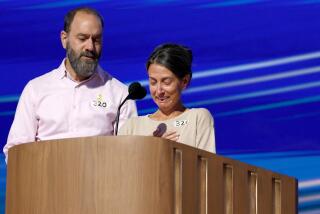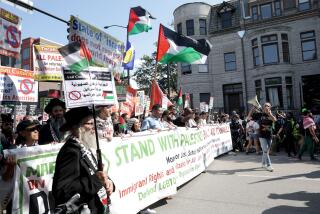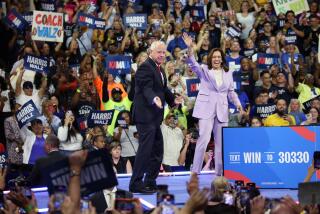Protesters to Relive ’68 in Chicago
- Share via
CHICAGO — In a crumbling mansion on the city’s north side, in a back room with purple tie-dyed curtains, the steady beat of a bongo drum kept pace with the ringing of bells-on-a-stick, over and over and over and over.
The sweet-acrid odors of incense and marijuana lingered on the stairs.
Mayer Vishner closed the door on the landing. Then he closed the door to his whitewashed room in the attic. His hands were shaking. His shoulder-length, graying hair was slick with perspiration.
“I had to find a place to hide,” he moaned.
He is 47 years old and not as ready as he thought to go back in time to 1968.
The musical “Hair” is playing, a Daley sits in the mayor’s office and the Democrats are gathering again to launch a bid to keep the presidency. The surface parallels to the Days of Rage, when police clubbed antiwar dissidents in this city’s streets in ‘68, have proved a potent lure for veteran protesters, a match seemingly as perfect as a flower-power decal and a Volkswagen van.
Scores of those who were present in ‘68, and more who wish they were, are making their way back for another round of demonstrations, fueled by nostalgia, idealism, self-promotion, profit and excellent partying prospects.
Pulling faded “Mr. Natural” T-shirts over middle-aged paunches, plucking their old plastic love beads out of storage, they hope the whole world will watch just once more.
The scene is laced with poignance. The graybeards are depending on the power of memory and the boredom of 15,000 journalists suffering from news deprivation over at the United Center, the site of the Democratic convention. The combination, they believe, offers them a rare chance at the spotlight for a host of issues overshadowed in 1968 by the immediacy of the Vietnam War--and often lost today in the crosscurrents of daily life. They will demonstrate for treatment of drug addicts, reform of the criminal justice system, cleanup of pollution, an end to discrimination. All were on the old agenda.
Many are also, for a moment, reliving an experience that was as profoundly personal as it was public.
Some also plan to make a buck. Paul Krassner, a founder of the Yippies, will hold forth at Borders Books tonight, touting and signing his latest collection of essays. The less famous will be selling refreshments, tie-dyed shirts and other souvenirs. “The people with the funny hair and clothes are some of the shrewdest business people you’d ever want to meet,” said Jack Clubb, a Madison, Wis., cabdriver helping to arrange some of the protest events.
Early arrivals are reminiscing already, establishing their bona fides: “I’ve been gassed in four cities,” Vishner boasted. On hearing a familiar name, Dana Beal, 49, recalled: “I was busted with her.”
Not likely this time. In Grant Park, where tear gas once broke up hippie encampments near convention delegates in the Hilton Hotel, protesters will sleep outside again. But in 1996, the city has issued permits allowing the overnight stay.
That doesn’t mean it will be easy.
David Dellinger, an organizer of the ’68 events and one of the Chicago Seven charged with conspiracy to incite a riot, will lead marches. (An eighth defendant, Bobby Seale, was tried separately). But in 1996, Dellinger isn’t sure whether he wants to engage in civil disobedience and risk arrest. He flew in from Vermont on the day he turned 81.
He is not the only one feeling his age. Aron “Pie Man” Kay, who gained mythic status for tossing customized pastry--Phyllis Schafly got a faceful of apple pie; G. Gordon Liddy, a chocolate Bavarian--says he will be on hand for various protests.
But at 44, he plans no deliveries. “My knees are shot now,” he said. “I can’t run away.”
Vishner, a longtime peace activist, ended up at his crash pad after calling several friends of friends from the airport upon his arrival from New York. “None of them worked out,” he said, and then he heard that a group of vendors from the Grateful Dead concert circuit was willing to put up guests. He got a mattress, a closet, an electric fan and a box topped by a flickering candle.
On the first floor of the house is a nerve center for protest coordination. Two computers and a copy machine are running in an alcove. The house’s younger occupants are pierced and tattooed. Some of the older ones, like Clubb, wear Izod shirts with their cutoffs. Others, like the woman who floated by, murmuring, “This is groovy,” are clad in saris.
Beal (in tweed jacket) is at the house too, but he’d like to find other accommodations. He can’t sleep because of all the noise, he said. “I’m only doing OK because I’ve got my melatonin.”
Clubb, 44, was better prepared. He brought along a vacuum and other cleaning supplies. “I can’t handle this mess,” he said.
Mass protest, for most, is an activity they ceased sometime during the 1970s. “I prefer not to leave the Village,” said Vishner, pining for his Manhattan home.
But Chicago is different. This place came to symbolize the divide between generations, between the counterculture and authority. The convulsions here not only helped elect Republican Richard Nixon president on a law-and-order platform, but they also helped lead to political reforms in which primary elections could replace party bosses’ orders.
And so, “a lot of people are coming alive, people I haven’t heard from in years,” Dellinger said.
Dellinger spent last much of last summer phoning radical lawyer William Kunstler, who had defended him in Chicago. Their preferred topic wasn’t the ‘60s, but their respective fungal infections and bypass operations.
Then, in September 1995, Kunstler died. At a memorial service for him here, Dellinger raised a fist and shouted a promise that if another famous Kunstler client, Leonard Peltier, remained in prison, “we’re going to organize nonviolent civil disobedience at the 1996 National Democratic Convention in Chicago!” Wild applause.
Remembrance exerts a pull even for ’68 alumni who plan to stay away from the marches and vigils. “If it wasn’t in Chicago, I don’t think I’d be coming,” said Leo Lalonde, chairman of the Macomb County, Mich., Democratic Party. Though he is not a delegate, he made an effort to get tickets to the spectators’ gallery.
In 1968, Lalonde was gassed at Grant Park. He’d come then, he says, “mainly to pick up women,” but was deeply affected by the police beatings. “I feel,” he said, “I have to bring this whole thing to closure.”
Some of the old guard predict tens of thousands will gather and young radicals, summoned by e-mail and faxes, will join them. Most, though, don’t expect much in the way of dramatics.
“Attempting to repeat the past ain’t gonna happen,” said Tom Hayden, once the leading voice of the New Left. He has told protest coordinators, Hayden said, that “if you get measured by ‘68, whatever happens here is going to be no good.”
On Sunday morning, Hayden will wake up in the Hilton, transformed into a member of the California Democratic delegation. Now a state senator, he helped organize a commemorative concert--”$15, Ticketmaster,” he says--at a theater inside Chicago’s lakefront exhibition hall. Such protest-movement stalwarts as Crosby, Stills & Nash, Bonnie Raitt and Jackson Browne are slated to perform. The Rev. Jesse Jackson will speak. Hayden, Dellinger and other members of the Chicago Seven will reunite.
“We should not relive it, but interpret it,” Hayden said. “Try to find its meaning for now, for today.” He talks of an urban peace movement to stop gang wars and of campaign-finance reform, to bring political clout back to grass-roots voters. He will speak at an environmental justice rally on Tuesday.
Others are less serious. When Mayor Richard M. Daley recently hoisted an official convention flag downtown, Wild Bill Steyert--in flowing beard, tricorn hat and a chest full of “Yippie ‘96” buttons--greeted him with a serenade.
“Won’t you please come to Chicago?” he warbled, beginning the chorus of a Graham Nash post-Days of Rage anthem.
All Steyert could provoke was a quizzical mayoral glance. Daley, the son of Chicago’s mayor in 1968, intends to keep the calm this time around.
As San Diego did for the Republican convention, Chicago has designated two sanctioned protest sites--one in Grant Park and one at a lot about 70 feet away from delegate parking. The reason was security.
Five plaintiffs sued, and U.S. District Judge James Moran ordered the city to allow 20 people at a time to stand between the delegates’ parking area and the United Center entrance.
When the city held lotteries to decide which groups would get which time slots, protesters dressed in stars-and-stripes top hats and American flag capes gathered to decry what they saw as an abridgment of their 1st Amendment rights.
“If I don’t do a lottery, they’ll say it’s fixed,” Daley said. He, for one, hopes the demonstrations get plenty of media exposure. “Most protesters are not bad people,” Daley said.
* A NEW CHICAGO: The Windy City is spruced up for Democratic convention. E1
More to Read
Sign up for Essential California
The most important California stories and recommendations in your inbox every morning.
You may occasionally receive promotional content from the Los Angeles Times.










